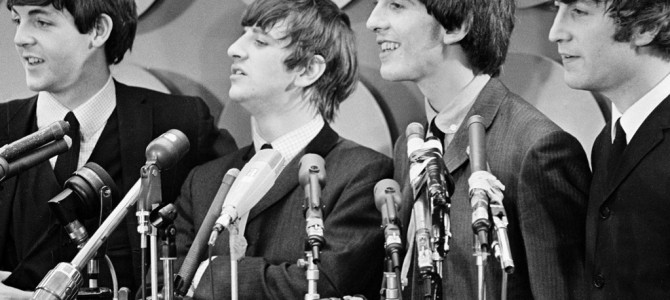
“The White Album” is a collection of brilliant fragments, along with some rather un-brilliant but still interesting fragments. It is the greatest album to be comprised largely of what would normally be called “filler”––great filler, conscious filler, artistic filler, but filler nonetheless.
Yet in the wild context of “The White Album,” these songs about birthday parties and non-stop flights to Moscow find their proper place and shine. It is a remarkably chaotic album. Yet as Paul McCartney himself notes, “There’s a fine line between chaos and creation,” and the album is triumphantly creative.
Most classic albums, from “Pet Sounds” to “Who’s Next,” have a relatively unified style or vibe. “The White Album,” however, ranges wildly from “Ob-La-Di Ob-La-Da” to “Revolution #9.” It features a compendium of styles, including blues, proto-punk, proto-metal, avant-garde collage, ragtime, folk, country, and more.
Topically, it includes a wholly satirical ode to the Soviet Union, the tale of a tiger hunter, a cowboy drama, a lament for a dead mother, a tribute to a sheepdog, a rant about the media’s treatment of Yoko Ono, a song about Eric Clapton’s sweet tooth, and a tune that overtly toys with a crackpot theory, current at the time, that McCartney died and has been replaced by a musician named Billy Shears. It is a remarkably varied work in every respect.
The Turmoil of ‘68
“The White Album” reflects some of our current cultural and political problems, while demonstrating many qualities that seem largely absent from our politically polarized and obsessed moment. The chaos and wildness that seethe beneath the album’s beauty, the anger in songs like “Piggies” and “Everybody’s Got Something to Hide Except for Me and My Monkey,” are still palpably with us.
However, the questing mentality of the album, its omnivorous tastes and cosmopolitan curiosity, seem to be rather lacking in our time. (At least, they are not immediately visible on the surface. You have to dig for them.) The Beatles had a Dionysian thirst for experience, an insatiable curiosity, a reckless and restlessly exploratory nature. All of this is fully evident on the White Album, experiencing its 50th anniversary this November.
Whereas “Sgt. Pepper’s Lonely Hearts Club Band” had a unifying style and an overarching concept, “The White Album” is intentionally centerless, ungrounded. Yet, for that very reason, it encapsulates the spirit of the hectic year in which it was released, 1968, and echoes with particular relevance in 2018.
As the Tet Offensive blazed through Vietnam, riots rocked the Western world from Chicago to Paris, and Martin Luther King Jr. and Robert F. Kennedy were both gunned down, the Beatles captured the conflicting impulses of peace and violence, love and hate, coursing through the cultural atmosphere. In the alternative version of “Revolution” on “The White Album,” “Revolution #1,” John Lennon sings, “If you talk about destruction, don’t you know that you can count me in,” whereas the single version of the song made it clear that you could count him “out.”
At the same time, George Harrison looks at the world and sees “the love there that’s sleeping” as his guitar “gently weeps.” While Lennon oscillates between anger and grace, and Harrison does the same, McCartney is tootling about shootouts in the Wild West and how much he loves his sheepdog. But then he sings, “Blackbird,” one of the album’s most moving songs. It all works.
An Album Born In the Himalayan Foothills
Even the album’s mode of conception reflects the spirit of the times, given that much of it was written on an extended meditation retreat at the Maharishi Mahesh Yogi’s ashram in India. The record’s history extends from the serenity of the Himalayan foothills where it was born, to sordid pseudo-hippie encampments in California’s Death Valley, where it was violently misinterpreted. It journeyed from the summits of geography and inspiration to their depths.
Indeed, the album was co-opted by the darkest currents running underneath American society at the time: Charles Manson delusionally claimed that “The White Album” was a set of messages urging him to provoke an international race war. Consequently, the title of one of the album’s songs, “Helter Skelter,” was found painted in blood on the walls of Sharon Tate’s home after Manson’s followers murdered her.
Even though its title is technically “The Beatles,” the album provides portraits of four individual musicians, rather than one of a unified band. Acting against the historical critical grain, contemporary critics now are trying to claim that it really is a unified vision, but they are, of course, totally wrong. “The White Album” is about the oddity, the off-kilter, the eccentric, the marginal. It isn’t seeking a unified vision and it does not intend to. That’s the point.
Individual differences and idiosyncrasies become paramount. Harrison is the spiritual visionary, the aspiring mystic. McCartney is the exaltation of Tin Pan Alley, a writer of ditties that transcend their ditty status to become luminous. Lennon is full of sadness, rage, and confusion, howling “Yes, I’m lonely, want to die” on “Yer Blues.” But against those feelings he manifests aggressive self-assertion and occasional tenderness, especially in the song for his dead mother, “Julia.” There is unquestionable poignancy when Lennon sings, “Half of what I say is meaningless––but I say it just to reach you.”
Ringo, well, it’s hard to explain, but he’s somehow an equally big presence, singing the closing number and successfully writing his first composition to make it onto a Beatles’ album, “Don’t Pass Me By.” As others have observed, the way he keeps the beat is always recognizable. The Beatles’ shell has cracked, letting these hatchling individual identities emerge and mature. The death of the band’s old identity attends the birth of four solo artists, who retain the ability to collaborate.
Lacking Unity But Gaining Order
The Beatles’ four separate and distinct personalities anchor the album. Even though they stand out from each other and do not meld into the unity that gave earlier Beatles records a certain flavor, they impose a little order on the White Album’s chaos. While it doesn’t have a unified vibe like “Sgt. Pepper,” it does have four unities bundled within it. These four personalities bounce off each other, argue with each other, talk to each other, connect with each other, and love each other.
Today, we can hopefully appreciate the relevance of that process of artistic communication. Each of the Beatles stands out as an individual, as a fully achieved personality, then offers that personality as an artistic gift.
In our own era, a fully achieved personality and artistic vision help act as a bulwark against Twitter mobs and collective rage. They give us something to appreciate that transcends politics. They assert the force of the individual imagination, propelling us towards the shores of light and away from the eddying currents that threaten to hurl us into non-being.
Songs like “Julia,” “Blackbird,” “Dear Prudence,” and “While My Guitar Gently Weeps” still have the power to reach us at a fundamental level and remind us that the personal is always greater than the political.









